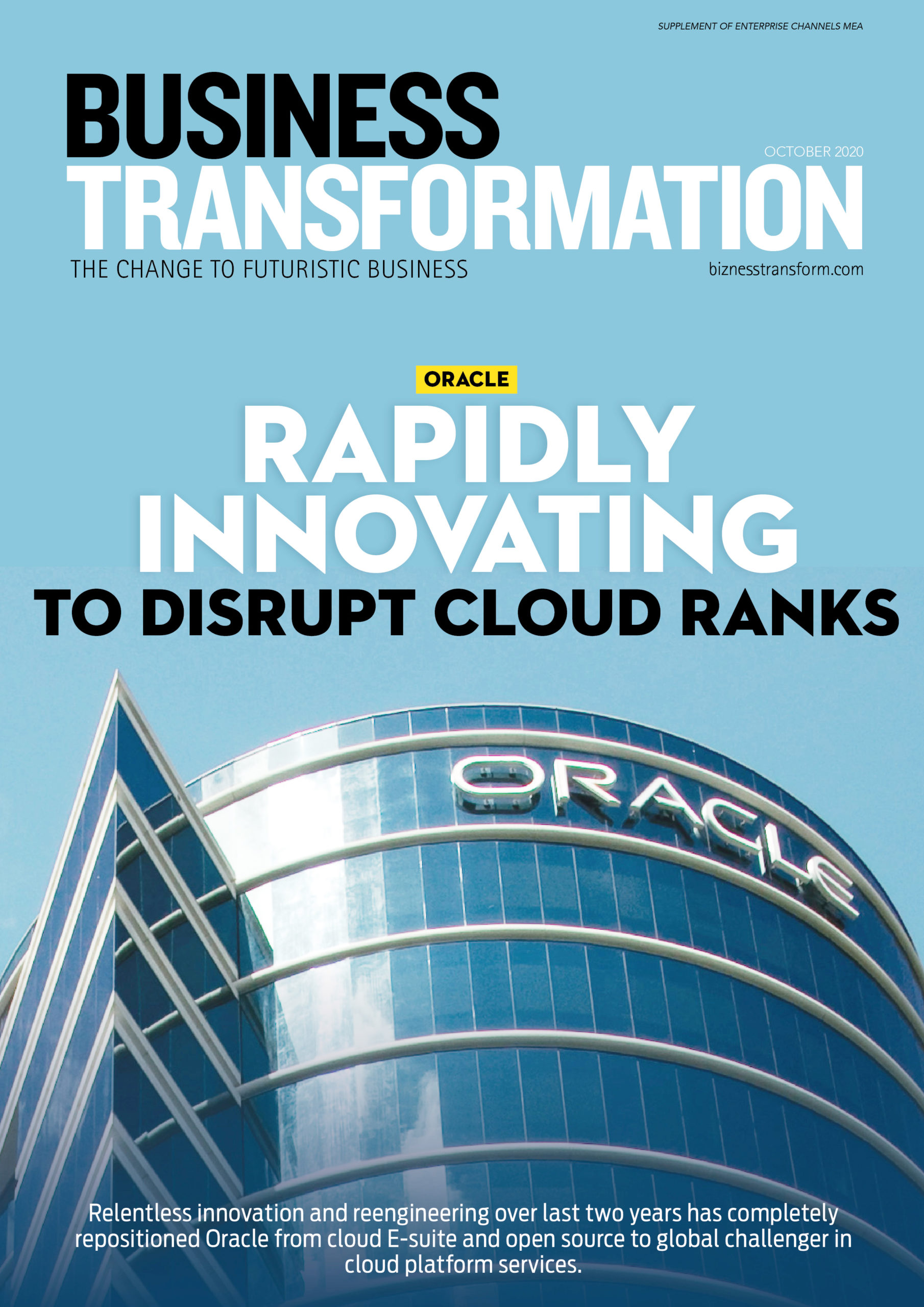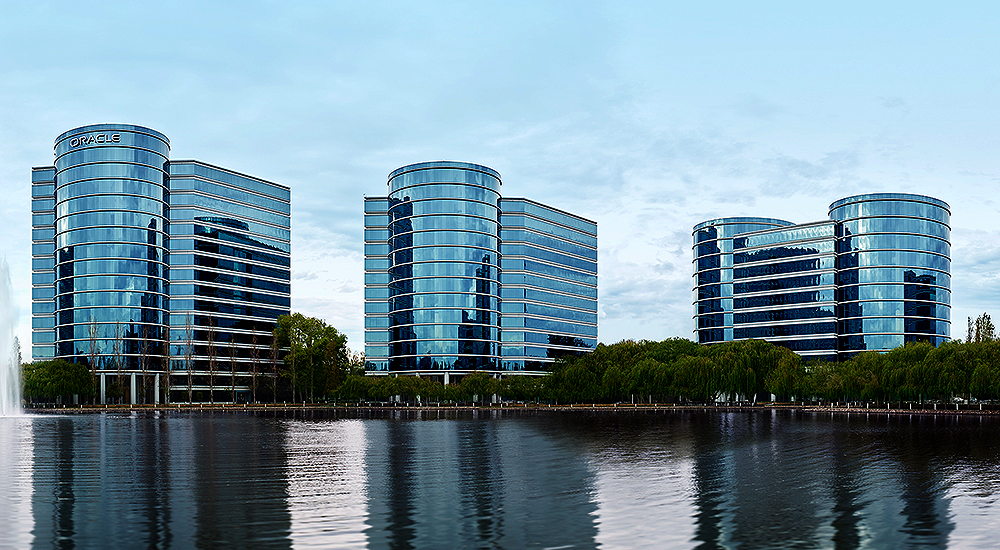Can Oracle’s rapid innovation and reengineering disrupt cloud ranks

Oracle started in its cloud journey more than ten years ago, in a manner of way that was different from its competitors. It started with its software application portfolio and built its Software as a Service, SaaS suite of solutions.
“We have started SaaS down, instead of infrastructure up. We started by redeveloping all our applications, as software as a service, and running on the same infrastructure and underpinnings,” says Regis Louis, Vice President Technology Product Strategy and OCI CoE EMEA, Oracle.
However, five years ago, in 2016, when Oracle started to develop its Infrastructure as a Service portfolio, it did a market assessment to understand the road map being followed by enterprises while embracing the public cloud.
Louis says the findings were shocking. “Adoption of the cloud was being mainly driven by new applications being built for the cloud. There was not much activity on adoption from key enterprises moving their critical workloads to the cloud,” he remarks.
What was happening was that enterprises were adopting new cloud native applications as part of their cloud adoption journey. They were not moving their mission critical workloads and data from on-premises to the cloud. And the reasons for this was multifold.
End users were reluctant to move their critical payloads to a public cloud platform because the migration process was perceived to be too complex and expensive. The levels of security built into the target public cloud platform were assessed to be primitive and inadequate. There was fear of platform lock-in, of being unable to move back to on-premises or another cloud platform. And lastly there were concerns about where the data will be hosted.
For government and public sector enterprises, the location of critical infrastructure workloads and data are dictated by the country’s data sovereignty rules and must reside within the same country or predesignated region.
Migration of critical on-premises applications to the cloud were therefore being hindered by a number of setbacks that existed across public cloud platforms, till just a few years ago.
End users were expressing their requirement to have identical cloud environments on-premises as well as in the public cloud, meeting the above requirements of performance, security, vendor-neutral, and data residency.
These were the compelling reasons why Oracle decided to build a brand-new architecture and a brand-new cloud from scratch. “All of this was not possible at that time. That has been our big motivation to create this brand-new architecture to address head-on these challenges,” says Louis.
Differentiating the platform
Oracle has now built its second-generation Oracle Cloud Infrastructure around a number of market differentiators. As its first differentiator, Oracle has done extensive engineering to introduce physical isolation in multiple security planes. There is isolation in the tenancy, network, virtualisation, and data planes. This is to prevent any attack from spreading across the network and amongst the tenants.
Louis points out that because Oracle has started late in building its second-generation cloud platform it has been able to bring in this differentiation on the security side. “Because we have started this architecture, after the others have already deployed their environment, we have a very distinct architecture on the security side.”
This process of isolation has also been extended outwards from the infrastructure layer to the database layer, operating system layer, and the point of presence on the network layer. “From core to edge type of security, has been the key focus of our engineering,” explains Louis.
The second differentiator is around having predictable performance from its Oracle Cloud Infrastructure. Louis points out that the majority of cloud platforms oversubscribe usage of their networking and compute infrastructure leading to unpredictable performance characteristics.
“You have to work on having a predictable performance. We have a network architecture that allows us to not only predict the performance, but we are also able to guarantee the level of performance, which is unique in the marketplace. We are the only one having SLA’s on performance,” elaborates Louis.
In addition to having predictable performance and availability, Oracle has also worked on being able to deliver predictable pricing. This is key for enterprises adopting the cloud journey.
A typical hidden cost is the network ingress and egress cost, when data is moved out of the organisation’s network into the public cloud. Oracle Cloud Infrastructure has nil data ingress and egress cost up to 10 Terabytes of exchange, after which there is a fixed cost.
“If you look at all the clouds out there, there are a bunch of costs that people do not anticipate and that does not make the cost predictable,” points out Louis. This proactive approach on pricing was partly responsible for the movement of 8×8 collaboration platforms to Oracle Cloud Infrastructure, whereby they trimmed 80% of their ingress egress costs.
As the third differentiator, Oracle Cloud Infrastructure has been built from the ground up to support open platforms, hybrid cloud and multi cloud. While the latest open source technologies have been incorporated, Oracle Cloud Infrastructure works the same whether it is accessed on-premises as a private cloud in the datacentre or from the public cloud.
As part of its multi-cloud interoperability, end users can seamlessly move workloads from Oracle Cloud Infrastructure to Microsoft Azure. It requires a single sign-on and the private interconnection makes it appear to be part of the same datacentre.
A fourth differentiator is the partnership ecosystem around Oracle Cloud Infrastructure, including VMware, as a key example. Customers can take their VMware workload and move that VMware workload to the Oracle platform with the exact same version of what they use inside their company.
“We support VMware as a native service on top of our infrastructure. This is different from what the competition has done with VMware,” says Louis.
Other public cloud platforms run VMware as a service. This means customers are giving the key and root access of their VMware environment to the cloud service providers. Also, part of the Oracle platform is the ecosystem of connectivity partners to connect to any kind of destination.
The fifth differentiator and probably the most important is the long-term vision of what Oracle Cloud Infrastructure intends to become.
“The big vision we have is making the cloud more and more autonomous, reducing the cost of operations, and making sure that people can focus on where it matters for the business,” points out Louis. “We have automated everything and we have pushed that automation to the extreme, with the introduction of autonomous software.”
The cloud journey should not just be a matter of moving from point A to point B. The entire process should deliver some benefits as well.
Through machine learning algorithms, software is able to operate itself without human intervention drastically reducing the operational cost, as well as human error associated with the operation. Oracle has applied this concept to its database that now drives, repairs, tunes, and secures itself. Autonomous has also been extended to the Oracle operating system and to its data replication.
Challenging the ranks
According to published reports from consulting firm Omdia, the global line up of top public cloud hyper scalar players include AWS, Microsoft, Google, Alibaba Cloud, Oracle, IBM and Tencent. “AWS is by far and away the biggest. It is the gorilla in the market and is growing high double digits, year on year,” says Roy Illsley, Chief Analyst, IT and Enterprise, Omdia. Oracle on the other hand has a more focused strategy according to Illsley.
“Oracle is very clear that they are going for enterprise mission critical workloads, and they built their Generation Two cloud, specifically to go after those types of workloads. They are being very focused on customers. And that is why you will not see them catching the likes of AWS and Microsoft, because they are not genuinely going out there to win any cloud business they can. They are being quite specific in what they can run, what they want to run and what they have designed their cloud to run,” adds Illsley.
An enterprise end user will choose the type of cloud platform that matches their workload. Oracle has built its Generation Two, Oracle Cloud Infrastructure to attract mission critical type of workloads. AWS and Microsoft have a different approach in the public cloud marketplace and offer something for everyone.
Continues Illsley, “AWS and Microsoft are very mature businesses that have got lots of different capabilities baked into their platform. If you are a customer, you are going to look at what cloud do I want for my workload. You are going to pick, based on how it matches the workload that you are putting in there. That is why I believe the likes of Oracle have gone for the mission critical type workloads.”
Where is the shakeup likely to be in the public cloud, hyper scalar ranks?
According to Omdia’s Illsley, the cloud opportunity is approximately 70-75% of all global workloads. 25-30% of all workloads will remain grounded inside mainframes and legacy sites. Currently the cloud market is at 35% penetration of the total opportunity.
Global consulting firm Omdia’s forecast is that 26% of all edge servers shipped will be for edge locations by 2024. “Given that edge computing is the new hype, I think that represents the best chance anybody has got of coming in with a new offering that can compete against the current cloud providers.”
The current offerings are either hardware at the edge; or software on any hardware at the edge. That leaves a gap for someone to come in with hyper scalar capabilities to offer services designed for the edge with the connectivity back to a limited number of hyperscale hubs.
A hyper scalar entering the market with a cloud edge offering can erode the corresponding market shares from the leading players. But it is a very immediate need, because the edge market will become well established by 2024-25.
The new entrant would also be competing against the existing offerings including AWS Outpost, Microsoft Azure Stack, Google Anthos, IBM Red Hat OpenShift, and Oracle Cloud@Customer.
What other differentiation would be required?
A hyper scalar player today would need to be a global player, with multiple points of presence in multiple regions, offering a range of cloud-based services for end users to consume. The hyperscale aspect is just the scale of it, since many cloud service providers have regional but not global scale. “A hyper scalar would need to be within so many milliseconds of a large proportion of the population, that would make them a hyper scalar,” says Illsley.
However, a key characteristic of modern day hyper scalar platforms is the role played by the autonomous function delivered by artificial intelligence and machine learning to automate operations.
Says Illsley, “The hyper scalars are all fully embraced with autonomous and I suspect that most of these hyper scalars cannot work without highly autonomous systems. The challenge is, those highly autonomous systems are built for their architecture and it is their intellectual property. So, they run their architecture very well. And if you are an enterprise customer wanting to put a large scale, private cloud, you cannot use what AWS or Microsoft use, because it is not a product, and it has been purpose built.”
That rule is applicable to all, but one of the hyper scalars. Oracle Cloud Infrastructure does offer an autonomous suite as part of its regular cloud offerings, to any of its end user customers.
The Oracle Autonomous Database was announced in 2018, and still remains the world’s only autonomous database. Successful usage of Oracle Autonomous Operating System Linux across 2019 and into 2020 and innovation within Oracle Autonomous Database since 2018, have led Oracle to launch its third offering, Autonomous Data Guard.
With Oracle Cloud Infrastructure demonstrating the most rapid change in market share in the last two years, it remains to be seen what position and what route to market this hyper scalar chooses to make in the months ahead. There are many and yet just a few possibilities to choose.
Also visit our October digital edition


(Left) Regis Louis, Vice President Technology Product Strategy and OCI CoE EMEA, Oracle
- Adoption of the cloud was being mainly driven by new applications being built for the cloud.
- That has been our big motivation to create this brand-new architecture to address head-on these challenges
- We have a very distinct architecture on the security side
- From core to edge type of security, has been the key focus of our engineering
- If you look at all the clouds out there, there are a bunch of costs that people do not anticipate
- We support VMware as a native service on top of our infrastructure
- The big vision we have is making the cloud more and more autonomous
- We have automated everything and pushed automation to the extreme
(Right) Roy Illsley, Chief Analyst, IT and Enterprise, Omdia
- AWS is by far the gorilla in the market, growing at high double digits
- Oracle is clear they are going for enterprise mission critical workloads
- Oracle built Generation Two cloud, specifically to go after those types of workloads
- Oracle are quite specific in what they can run, what they want to run and what they have designed their cloud to run
- AWS and Microsoft are mature businesses that have lots of different capabilities baked into their platform
- Given edge computing is the new hype, that represents the best chance anybody has got of coming in with a new offering
- A hyper scalar would need to be within milliseconds of a large proportion of the population
- I suspect that most hyper scalars cannot work without highly autonomous systems.
- Those highly autonomous systems are built for their architecture and it is their intellectual property

Why Oracle needs to be considered amongst hyper scalar top ranks
In 2016, Oracle became a serious contender in the cloud market when it launched its Platform as a Service and Infrastructure as Service offerings, around its E-business suite of cloud applications. The original vision of this Generation One platform was to support its own Software as a Service products. Now four year later, Oracle has built what it calls its Generation Two cloud platform.
Oracle’s historical approach towards building its cloud platform has been different from its current-day platform. When Oracle Cloud Infrastructure, Generation One was first launched, it was a barely viable product. It was built using an architecture that was optimized for Oracle’s cloud solutions and other similar scale-up workloads. The platform was never meant to compete with other hyper scalars in the public cloud market place.
Oracle Cloud Infrastructure, Generation Two platform has been vastly expanded and now supports general-purpose workloads, cloud-native workloads, virtual machines and Kubernetes-based container service. Oracle’s modern day and present-day intention is now amply visible. Oracle is starting to position itself as a viable option for supporting non-Oracle workloads. In other words, entering the fray of becoming a fully deployed hyper scalar, public cloud player.
According to Gartner analysts Tobi Bet and Miguel Angel Borrega in a descriptive report published during July – August 2020, Oracle’s annualized consumption revenue around Oracle Cloud Infrastructure grew by 140% in Q4 2020. Oracle is now trying to rid itself of the shackles that it built when it first launched its Generation One platform. That was a platform built only for Oracle’s product suite.
Oracle is no longer a software company. Oracle Cloud Infrastructure, Generation Two, on the other hand has integrated SaaS, IaaS, and PaaS offerings, and has broad enough capabilities to support general purpose workloads. Oracle Cloud Infrastructure, Generation Two, also remains the most suitable platform to use when migrating legacy ERP and HCM applications to the cloud. This is true when the enterprise is considering a hybrid cloud approach.
According to Gartner’s Bet and Angel Borrega, there are 270 objective capabilities, expected by enterprises from any cloud IaaS and PaaS provider. Gartner evaluates the global cloud providers on these objective parameters and publishes the results in its annual Solution Scorecards. Across the public cloud marketplace, including AWS, Azure, Google Cloud Platform and Alibaba Cloud, the Gartner scores improved the most for Oracle.
Another green light according to Gartner’s Bet and Angel Borrega, was when Oracle Cloud Infrastructure, Generation Two’s capabilities crossed a critical threshold in 2020, making it a reasonable option for enterprise production use.
Gartner’s monitoring shows that Oracle Cloud Infrastructure has a good track record of service availability. While Oracle Cloud Infrastructure, was architected and optimized for hosting Oracle’s ERP and database applications, the vendor has recently been successful in winning workloads using non-Oracle technologies.
Oracle Cloud Infrastructure won an award to become the second core platform, alongside AWS, for the collaboration service provider Zoom, providing immediate overflow and additional capacity.
Oracle has demonstrated its commitment to the global market with a significantly increased presence, in terms of Oracle Cloud Infrastructure regions served with a single availability zone. Geographic presence is an area where Oracle has lagged behind the competition, and it has only recently been addressed. Oracle has invested to complement its offerings with further expansion in regional data center build-outs and by developing and enabling cloud adjacent strategies.
Oracle Cloud Infrastructure’s Dedicated Cloud@Customer Region offers the complete Oracle Cloud Infrastructure implemented in-country. It includes all Oracle Cloud Infrastructure public cloud services available and delivered identically to a customer’s data center on-premises or colocation.
Oracle Cloud Infrastructure is the only option for accessing Oracle solutions via a SaaS model, as AWS and Azure can run Oracle solutions just on IaaS and PaaS.
Why is the market beginning to take Oracle Cloud Infrastructure platform more seriously?
- Oracle Cloud Infrastructure offers a high-performance IO platform to speed up the usage of Oracle Database.
- Oracle Cloud Infrastructure offers Autonomous Database, dedicated to house critical systems of record.
- Oracle Autonomous Database can tune databases automatically, update and patch without downtime, and provide DBMS security.
- Oracle Cloud Infrastructure drive performance using multiple regions per country, architecture, fault domains, availability domains.
- Oracle Cloud Infrastructure has been designed to avoid oversubscription.
- Oracle Cloud Infrastructure supports hybrid cloud by enabling cloud adjacent strategies, such as Cloud@Customer.
- Oracle customers can migrate and run VMware vSphere workloads on Oracle Cloud Infrastructure since 2019.
- Oracle Cloud Infrastructure is the only hyper scalar in the Gartner Magic Quadrant with a datacentre in Saudi Arabia.
- Oracle has thoughtfully architected, hyperscale cloud architectures that are competitive with established cloud providers.
- Oracle Cloud Infrastructure has made substantial YoY gains in IaaS and PaaS capabilities, as defined by Gartner.
- As stated by Gartner, unlike its competitors, Oracle delivers all capabilities simultaneously into all regions globally.
Excerpted from It’s Time to Include Oracle as a Viable Option When Evaluating Public Cloud Providers, Gartner Analysts Tobi Bet, Miguel Angel Borrega, 7 August 2020; and SWOT Assessment Oracle Cloud Infrastructure, Omdia Consulting.
Also visit our October digital edition






